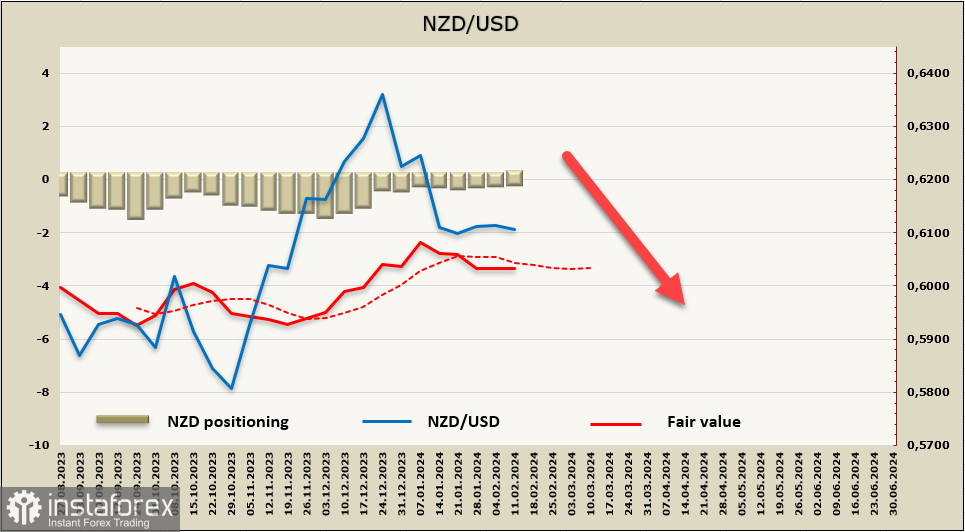On Tuesday, the focus was on the Consumer Price Index (CPI) data for January, and it actually turned out to be surprising. Inflation in January fell to 3.1%, from 3.4% in December (forecast 3.1%), while the core inflation remained unchanged at 3.9% (forecast 3.7%). It is worth noting that the Federal Reserve closely monitors core inflation, and the fact that it has stopped falling was perceived by the markets as a clear hawkish signal, which sent the USD exchange rate and bond yields higher.
In general, unexpectedly high data confirm that the U.S. economy is far from cooling down. Economic growth is clearly above forecasts, and immediately after the release of inflation data, the futures market adjusted expectations for the first rate cut. Now the probability of a rate cut in May is less than 50%, and expectations are being pushed to June. This is a clear hawkish signal for the USD, and we don't expect the dollar to weaken again in the foreseeable future.
NZD/USD
The kiwi rose last week due to the unexpected change in ANZ's forecast, which currently sees two more Reserve Bank of New Zealand rate hikes in the next two meetings. However, the effect was short-lived as the market quickly expressed skepticism about this scenario. Nevertheless, concerns that the RBNZ may resume the tightening cycle have increased, and the market is now expecting the first rate hike by May.
The risk of such a scenario does exist, and if the hawkish scenario implies two rate hikes, and the RBNZ's baseline scenario is four cuts, the market forecast sees one rate hike in May. This would raise the rate to 6%, and the realization of this scenario would give the kiwi a reason to strengthen against the backdrop of higher yields.

Inflation expectations, according to the RBNZ's assessment, have decreased from 2.76% to 2.50% over the next two years. Everything seems to be going according to plan, but the bank itself sees inflation higher than these expectations. On Friday, RBNZ Governor Adrian Orr will deliver a keynote address at the New Zealand Economic Forum, discussing the changing forces of inflation over the past couple of years and the transition from temporary to more sustainable core inflation. Obviously, if his speech sounds hawkish, the kiwi may experience another upward spike.
Positioning on the NZD remains neutral, with a weekly change of +114 million, and a small long position of +51 million has been formed. The price is below the long-term average, suggesting pressure on the kiwi, but the momentum is weak.

NZD/USD is moving down from the sideways range. An attempt to settle above the resistance area of 0.6105/20 failed, and we expect the pair to fall, with the nearest target at 0.6033, then 0.5995.
AUD/USD
Employment data will be released on Thursday, which is a key report. Australia unexpectedly shed 65,000 jobs in December, while January is forecast to see a 30,000 increase in new jobs and an increase in unemployment from 3.9% to 4.0%.
The January NAB business survey showed that business confidence remains at a low level, conditions have declined and are slightly below the long-term average. The industry is also below the average level, and even the services sector showed signs of slowing down. There has been a noticeable acceleration in the growth of prices in retail trade and prices for goods in general, reflecting the ongoing ability of companies to shift some costs to consumers.
As for the forecasts for the RBA interest rate, they will undoubtedly remain high for a long time. In terms of supporting the AUD rate, this is a positive signal as it keeps yields competitive. However, the pressure on businesses due to restrictive monetary policy is increasing.
Positioning on the AUD continues to deteriorate. Over the reporting week, the net short position increased by 836 million to -4.684 billion, and the price is firmly decreasing.
AUD/USD briefly consolidated after forming a local low at 0.6471. We expect the pair to fall further. The medium-term target remains the same, which is the local low from October 26 at 0.6275. There are practically no prerequisites for a bullish reversal, and this is considered an unlikely scenario.
 English
English 
 Русский
Русский Bahasa Indonesia
Bahasa Indonesia Bahasa Malay
Bahasa Malay ไทย
ไทย Español
Español Deutsch
Deutsch Български
Български Français
Français Tiếng Việt
Tiếng Việt 中文
中文 বাংলা
বাংলা हिन्दी
हिन्दी Čeština
Čeština Українська
Українська Română
Română

